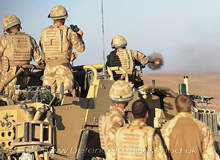
Much has been made in recent years of shortages of essential personal protective equipment in both Iraq and Afghanistan, most usually the lack of body armour or its perceived inadequacy. This is understandable and reflects a highly charged political arena, where the accusation that ‘our boys’ have been let down through personal equipment shortages is raised on all too frequent occasions. Yet this is a very recent concern and was largely absent from previous campaigns. Something has changed in our collective perceptions of the management of risk to life and limb.
Take the wearing of helmets in counterinsurgency (COIN) and internal security (IS) situations. Even a cursory study of Britain’s own experience indicates that the helmet was seen as a necessary adjunct for but a few situations, such as the early days in Northern Ireland where almost daily mass rioting was the norm.
There were good reasons for the absence of helmets: they were of World War 2 vintage and designed to protect under intense shell fire, very uncomfortable to wear and very hot when the internal wool liner was fitted. The elastic strap ensured that it ‘bounced’, especially when running. Only the parachute helmet, with its leather inner, close-to-skull design and mouth retaining strap was considered fit for purpose and was the envy of non-para units.
In most previous COIN/IS situations, especially in the hot dry (Cyprus, Kenya, Aden, Dhofar) or humid (Malaya) environments, the helmet was considered an unnecessary encumbrance and far better replaced with a beret, shemagh or jungle hat. Those who claim that the intensity of combat in these operational environments was so low as not to merit the wearing of helmets would do well to examine the statistics for ‘incomers’ in, for example, the Dhofar campaign. At Sarfait, on the border with the People’s Democratic Republic of Yemen, even in the closing phase of a war that lasted almost 15 years, 403 ‘incomers’ were recorded in a single week in January 1976. Yet as the photographic records show, there was not a helmet in sight.
It is also worth remembering that the compulsory wearing of helmets on the streets of Belfast in Northern Ireland only took effect from the hot summer of 1989 until the 1994 ceasefire, with berets being the norm for the previous 20 years, unless on riot duty.
See Also:
Body armour
How well do you really know your competitors?
Access the most comprehensive Company Profiles on the market, powered by GlobalData. Save hours of research. Gain competitive edge.

Thank you!
Your download email will arrive shortly
Not ready to buy yet? Download a free sample
We are confident about the unique quality of our Company Profiles. However, we want you to make the most beneficial decision for your business, so we offer a free sample that you can download by submitting the below form
By GlobalDataThe use of body armour was similarly slow in coming. There was none at all in the pre-Northern Ireland COIN campaigns and none was issued for the Falklands war of 1982.
Even were it available, the weight of essential kit – weapons, ammunition, water, food, some dry clothing if lucky – would probably have precluded its use. Only in more recent conflicts, notably Iraq and Afghanistan, has body armour assumed the level of ‘essential’ as opposed to ‘optional’ protection. Yet commanders at the tactical level of operations have on several occasions felt that their advice to the chain of command on the practicalities of wearing of body armour and helmets has been cursorily ignored.
Take the experience of 4 Rifles Battle Group in Basra in May to November 2007, where according to its commanding officer (CO) his soldiers were required to carry kit weighing 80lb in temperatures of 50°C, which rose to 72°C inside the Warrior Infantry Fighting Vehicle. Not surprisingly, heat exhaustion was prevalent among vehicle crews.
Another CO made a similar comment concerning the Osprey body armour in Afghanistan being ‘of little practical value, but weighed 30lb’.
The tendency for the MoD chain of command to dictate ‘best practice’ regardless of the actual situation being faced is disturbing. In 2006, Stuart Tootal, the former CO of 3 Para, said: “By the end of 2007 the red tape surrounding the conduct of operations had grown significantly and a different approach to risk was being enforced. Heavy body armour and standard-issue infantry helmets became compulsory and we were not allowed to train wearing the lighter armour and para helmets we had previously worn.
“The standard-issue kit offered better ballistic protection, but it was heavy, ill-fitting and impeded mobility. Troops could not adopt proper fire positions wearing it and it also slowed them down and reduced their endurance; all critical factors in avoiding enemy fire and killing your opponent before he can kill you. However, the policy makers were adamant that we should wear it and banned soldiers from wearing lighter, improved ballistic protection even though they were prepared to buy it themselves.”
In part, these developments reflect a litigious compensation culture that is all too evident in wider society – the notion that somebody else must be held accountable for every failure, especially where lives are lost or serious injury sustained. But in conflict it is impossible to mitigate all risk. Every soldier knows this.
The COs cited above were well aware that managing risk was at the core of their business and the responsibility is indeed awesome, for when things go wrong, every CO knows the buck stops with them. In an alleged era of ‘mission command’ it is high time that responsibility in matters such as these is delegated where it belongs, to those in command on the front line.



